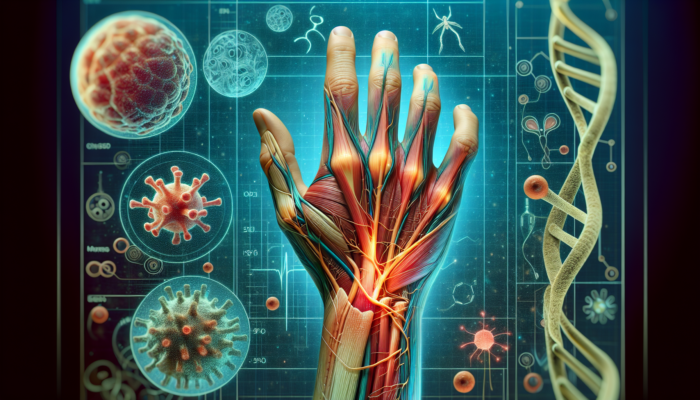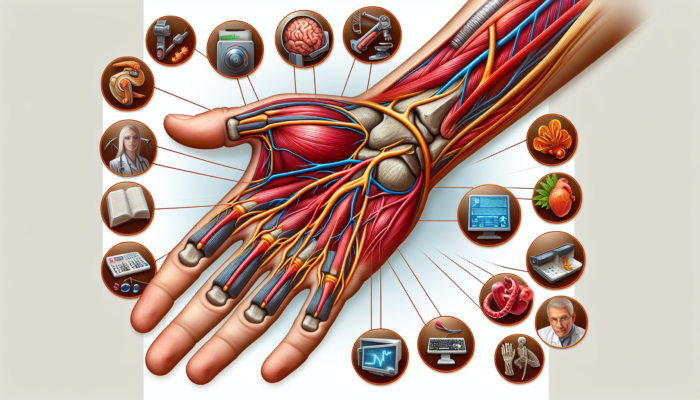Discover the Life-Changing Benefits of Acupuncture for Effective Carpal Tunnel Syndrome Management
Acupuncture has emerged as a highly regarded treatment option for individuals grappling with the debilitating symptoms of carpal tunnel syndrome. This ancient healing practice not only alleviates pain but also targets the underlying issues causing discomfort. If you are experiencing distressing sensations like numbness, tingling, and weakness in your hands and wrists, understanding how acupuncture for carpal tunnel relief operates can profoundly change your life. In this in-depth article, we will delve into the complexities of carpal tunnel syndrome, the essential role of acupuncture in alleviating its symptoms, and the extensive benefits available to those affected.
Understanding Carpal Tunnel Syndrome: A Comprehensive Overview

Essential Insights into the Nature of Carpal Tunnel Syndrome
Carpal tunnel syndrome (CTS) is a prevalent condition marked by a variety of uncomfortable sensations in the hand and arm. This disorder occurs when the median nerve, which passes through the carpal tunnel in the wrist, becomes compressed. Such compression can lead to symptoms that disrupt daily activities and severely impact quality of life. Gaining a thorough understanding of this condition is crucial for those seeking effective treatment options, including acupuncture for carpal tunnel relief. By familiarizing yourself with CTS, you can more effectively navigate the path toward healing and enhanced well-being.
Recognizing the Common Symptoms Associated with Carpal Tunnel Syndrome
Individuals dealing with carpal tunnel syndrome often describe a distressing range of symptoms, which may include:
– Persistent pain radiating from the wrist into the hand.
– Numbness or tingling feelings that extend into the fingers.
– Noticeable weakness in grip strength, making it increasingly challenging to perform simple tasks like grasping objects.
These symptoms can profoundly disrupt sleep patterns and daily routines, prompting many to seek effective treatments, such as acupuncture for carpal tunnel relief, to regain control of their lives and enhance their overall health and well-being.
Examining the Causes and Risk Factors of Carpal Tunnel Syndrome

Understanding the fundamental causes of carpal tunnel syndrome is vital for developing effective treatment and prevention strategies. Common risk factors contributing to the emergence of this condition include:
– Repetitive hand use: Engaging in activities that involve prolonged wrist flexion, such as typing or working on an assembly line, can significantly increase the risk of developing CTS.
– Wrist injuries: Prior injuries to the wrist may elevate the likelihood of nerve compression and the ensuing symptoms.
– Health conditions: Certain medical conditions, including diabetes, rheumatoid arthritis, and thyroid disorders, can also heighten the risk of developing CTS.
By recognizing these risk factors, individuals can take proactive measures to prevent the onset of symptoms and seek timely interventions when necessary, promoting their overall health.
Understanding How Acupuncture Provides Relief for Carpal Tunnel Syndrome
Grasping the Foundational Concepts of Acupuncture
Acupuncture is deeply entrenched in the principles of Traditional Chinese Medicine (TCM), which posits that a vital energy called ‘qi’ circulates through specific pathways in the body. By stimulating targeted acupuncture points, practitioners aim to restore balance and alleviate pain. This ancient technique goes beyond mere needle insertion; it encompasses a holistic approach to health that addresses both symptoms and the underlying imbalances that contribute to the condition, thereby fostering a more comprehensive health experience.
Key Acupuncture Points for Optimal Relief from Carpal Tunnel Syndrome Symptoms

Several specific acupuncture points have been identified as particularly effective in offering acupuncture for carpal tunnel relief. Important points include:
– PC6 (Neiguan): Located on the inner forearm, this point is renowned for its ability to alleviate wrist pain.
– LI4 (Hegu): Found on the hand, this point is widely celebrated for its strong pain-relieving properties.
– TH5 (Waiguan): Situated on the outer forearm, this point is known to reduce inflammation effectively.
Focusing on these critical points can enhance blood flow and relieve nerve pressure, effectively addressing the symptoms related to carpal tunnel syndrome and fostering a sense of relief.
Investigating the Mechanism of Pain Relief Through Acupuncture
The efficacy of acupuncture in alleviating pain primarily hinges on its capacity to reduce inflammation and nerve pressure. By stimulating specific acupuncture points, the body releases endorphins, which serve as natural painkillers that promote relaxation and comfort. Furthermore, acupuncture enhances circulation, ensuring that vital nutrients reach the affected areas, which facilitates recovery and the healing process.
Scientific Research Supporting Acupuncture as a Viable Treatment for Carpal Tunnel Syndrome
An expanding body of research supports the effectiveness of acupuncture in addressing carpal tunnel syndrome. Numerous studies have indicated that patients who undergo acupuncture treatment report significant decreases in pain levels and improvements in hand functionality. This compelling evidence positions acupuncture as a credible and effective alternative to traditional treatment methods, offering hope to those in search of relief.
Highlighting the Abundant Benefits of Acupuncture for Carpal Tunnel Syndrome Relief
The Advantages of Non-Invasive Treatment Modalities
One of the most appealing aspects of acupuncture is its non-invasive nature. Unlike surgical procedures, which can present considerable risks and often require extensive recovery times, acupuncture provides a safer alternative that does not depend on medication or invasive techniques. This makes it a favorable choice for individuals seeking effective and compassionate relief from carpal tunnel syndrome.
Experiencing Significant Reductions in Pain and Inflammation
Many patients report immediate and lasting relief from pain and inflammation following acupuncture sessions. Numerous individuals find that their symptoms significantly improve after just a few treatments, making this approach a compelling option for those seeking quick and effective results.
Enhancing Hand Functionality and Dexterity Through Consistent Acupuncture Treatments
<pRegular acupuncture sessions can lead to improvements in grip strength and hand dexterity, enabling individuals to perform daily tasks with greater ease and efficiency. This enhancement is particularly beneficial for those whose jobs require fine motor skills, allowing them to execute their work more effectively and with less discomfort.
Adopting a Holistic Health Perspective with Acupuncture
Acupuncture perceives the body as a unified whole rather than isolating symptoms. This holistic approach can lead to overall health enhancements, addressing not only the pain tied to carpal tunnel syndrome but also any underlying imbalances, thereby fostering a deeper sense of well-being.
Preparing for Your Acupuncture Session: Crucial Steps for Optimal Success
Choosing a Qualified Acupuncturist for Best Treatment Results
Selecting a certified and experienced acupuncturist is vital to ensure a successful treatment experience. Seek practitioners with the relevant qualifications and positive patient reviews. A skilled acupuncturist will have a profound understanding of the techniques and nuances involved in effectively treating carpal tunnel syndrome, thus increasing the chances of achieving satisfactory results.
What to Expect During Your Initial Acupuncture Consultation
During your first appointment, the acupuncturist will conduct a comprehensive assessment of your symptoms and medical history, creating a customized treatment plan tailored to your unique needs. Be prepared to discuss your specific concerns, as this information will help formulate a personalized strategy for your acupuncture for carpal tunnel relief.
Pre-Session Tips to Maximize Your Acupuncture Experience
To enhance the effectiveness of your acupuncture experience, consider implementing the following pre-session strategies:
– Ensure proper hydration to support your body’s response to treatment.
– Refrain from consuming caffeine, as it can impede relaxation and comfort during the session.
– Wear loose-fitting clothing that provides easy access to acupuncture points.
These simple yet effective actions can greatly improve the results of your acupuncture session, setting the stage for successful treatment.
Exploring Advanced Acupuncture Techniques for Enhanced Carpal Tunnel Relief
Understanding the Nuances of Needle Insertion Techniques in Acupuncture
Acupuncturists employ various needle insertion techniques, ranging from shallow to deep, depending on the specific acupoint targeted and the patient’s comfort level. This adaptability ensures that each session is customized to meet individual needs and preferences, maximizing the possible benefits of treatment.
Enhancing Treatment Outcomes with Electroacupuncture
Some practitioners utilize electroacupuncture, which involves applying electrical stimulation to the needles, thereby amplifying treatment results. This technique can accelerate the pain relief effects of acupuncture, streamlining the body’s healing process.
Integrating Acupuncture with Cupping Therapy for Superior Results
Combining acupuncture with cupping therapy can yield outstanding therapeutic outcomes. Cupping therapy creates suction on the skin, enhancing blood circulation and relieving muscle tension, which complements the effects of acupuncture and boosts overall treatment effectiveness.
Utilizing Moxibustion for Enhanced Therapeutic Benefits
Moxibustion, which involves the application of heat to specific acupuncture points, can intensify the level of relief achieved. This method enhances circulation and alleviates discomfort, making it a valuable addition to acupuncture treatments for carpal tunnel syndrome.
Integrating Acupuncture with Complementary Therapeutic Approaches
Enhancing Outcomes by Combining Acupuncture with Targeted Physical Therapy
Pairing physical therapy with acupuncture can be exceptionally beneficial. Tailored exercises designed to strengthen wrist and hand muscles can enhance the pain relief achieved through acupuncture, ultimately promoting better functionality and mobility in the affected areas.
Chiropractic Care: A Complementary Approach to Boost Acupuncture Treatment
Chiropractic adjustments can improve overall wrist and hand health by correcting misalignments contributing to carpal tunnel syndrome. By integrating chiropractic care with acupuncture, patients can optimize their treatment outcomes and achieve comprehensive relief.
Massage Therapy: A Synergistic Approach to Comprehensive Healing
Massage therapy techniques can effectively relieve muscle tension and enhance circulation, working in tandem with acupuncture to achieve optimal results. Regular massage can help maintain the benefits derived from acupuncture sessions, supporting long-term relief and recovery.
Boosting Acupuncture Effectiveness with Herbal Remedies
Incorporating herbal medicine can further amplify the positive effects of acupuncture. Certain herbal supplements are known for their ability to reduce inflammation and promote healing, thereby creating a holistic approach to managing carpal tunnel syndrome and its associated challenges.
Real-Life Success Stories: Inspiring Acupuncture Experiences
Case Study 1: A Musician’s Inspiring Journey to Pain Relief and Recovery
Consider the remarkable story of a musician who suffered from debilitating wrist pain. After undergoing a series of acupuncture sessions, they experienced significant relief, allowing them to return to their passion for music without discomfort, reigniting their love for their craft.
Case Study 2: An Office Worker’s Victory Over Chronic Wrist Pain
An office worker struggling with chronic wrist pain found success through acupuncture. With ongoing treatments, they regained hand functionality, enabling them to perform their job duties without interruption, which greatly enhanced both their productivity and overall quality of life.
Case Study 3: A Mother’s Experience of Relief During Pregnancy
A mother experiencing carpal tunnel symptoms during her pregnancy discovered that acupuncture provided her with essential relief. This non-invasive treatment allowed her to navigate her pregnancy comfortably, significantly improving her overall well-being during this important stage of life.
Case Study 4: An Athlete’s Journey Back to Peak Performance with Acupuncture
An athlete striving to achieve peak performance turned to acupuncture for assistance with persistent wrist pain. Following multiple sessions, they reported substantial improvements, allowing them to resume training and competition, thus supporting their athletic ambitions and goals.
Addressing Your Common Questions About Acupuncture for Carpal Tunnel Syndrome
What Is the Recommended Frequency of Acupuncture Sessions for Optimal Relief?
Generally, a range of 6-12 sessions is recommended for achieving substantial relief; however, the exact number may differ based on the severity of symptoms and individual responses to treatment.
Is the Acupuncture Procedure Painful?
Most patients report minimal discomfort during acupuncture sessions, often describing the sensation as a gentle prick or mild tingling, which is usually well-tolerated.
Can Acupuncture Completely Cure Carpal Tunnel Syndrome?
While acupuncture may not offer a complete cure for carpal tunnel syndrome, it can significantly reduce symptoms and improve overall well-being, making it a valuable component of a comprehensive treatment strategy.
Are There Any Possible Side Effects Associated with Acupuncture?
Side effects are rare; however, they may include bruising or soreness at the needle insertion sites, which typically resolves quickly after treatment.
How Long Can I Expect the Results of Acupuncture to Last?
The duration of results can vary; however, many patients report experiencing long-term relief, especially when engaging in regular maintenance sessions to sustain the benefits.
Connect with us on Facebook for More Insights and Updates!
The Article: Acupuncture for Carpal Tunnel: Essential Relief Guide appeared first on https://mcrtherapies.co.uk
The Article Acupuncture for Carpal Tunnel: Your Essential Relief Guide appeared first on https://mcrtherapies.com
The Article Acupuncture for Carpal Tunnel: Essential Relief Strategies Was Found On https://limitsofstrategy.com

